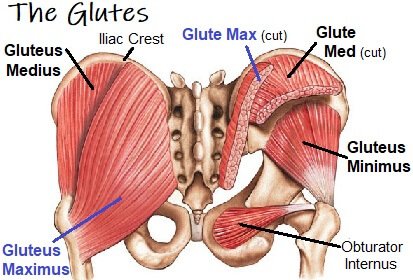If you’ve ever worked with me, you know that I’m slightly obsessed with training glutes, but it’s about way more than aesthetics…although “mom butt” is a thing, so glute exercises are key to combat the flat butt appearance that can occur during or after pregnancy.
The reason I include glute exercises in every session is because they play a major role in both hip stability and movement (they also provide stability for the knee, SI joint, and spine, but that’s for another post). In this article, I’m hoping I can convince you that training your glutes two times per week is essential for your hips…and aesthetics.
Let’s talk about anatomy first. You actually have three muscles that make up the glutes. When any of these muscles are weak or tight, your hips are impacted.
The gluteus maximus is the superficial gluteal muscle and is the largest of the trio. This is the one that makes up the shape of your butt/hips. The gluteus maximus is responsible for the force required to stand from a seated position, go up the stairs, or generate power in athletic movements. The primary movement of the gluteus maximus is to extend your hip (bring the leg backward or stand upright from a bent position), as well as external rotation of the hip.
Image from Knee-pain-explained.com
The glute medius is a broad fan-shaped muscle found between the maximus and minimus, as a middle layer. It works with the minimus to provide hip stability when one leg is off the ground, like when you’re standing on one leg or during walking and running. The gluteus medius also works with the minimus to abduct your hip (lift your leg out to the side). Your pelvis won’t be as stable if your glute medius is weak, which can then cause issues in your knees and lower back.
The glute minimus is also fan-shaped and is the smallest of the glute muscles. It also lies deepest, under the glute medius. The glute minimus assists the glute medius in the stability of the pelvis, hip abduction, and hip rotation. If you’re lifting your leg out to the side, or standing on one leg, this muscle is activated.
So now that you know there are three glute muscles, let’s talk a bit more about what they do and the exercises that train them.
As already mentioned, they are stabilizers. They work with other core muscles to help stabilize your trunk and hip, which helps with posture and proper alignment. This is why if you’ve ever been in physical therapy, glutes are usually a part of the program. Outside of stability, you’ve learned that glutes are responsible for hip movement, which are as follows:
Hip extension refers to straightening at the hip joint. This can happen when standing from a bent or seated position, or when you extend your leg backward. If your glutes are weak then you might overuse your back muscles when bending and lifting, causing pain or even injury.
Hip abduction is when your leg moves away from the midline of your body. Your glutes help your legs move in this direction, but also provide stability by activating in movements that could cause too much or too little rotation, like when you perform wide stance squats.
Hip rotation is when your thigh rotates away from your midline.
Now let’s take a quick look at examples of glute exercises.
There are several variations of hip abduction, extension, and rotation exercises, which means you can continue to make progress by progressively challenging yourself.
The gluteus maximus is activated both in horizontal and vertical exercises. Vertical exercises would be variations of squats, lunges, deadlifts, step-ups, and kickbacks. Horizontal exercises would be variations of hip thrusts and glute bridges.
The glute medius and minimus are activated during hip abduction and rotational exercises. Examples of these include the quadruped fire hydrant, seated abduction machine, clam shells, band wood chops, or lateral mini band exercises like shuffling and side leg lifts.
After you become pregnant, you probably become more aware of your hips than ever before. If you’re in need of more strength and stability, glutes are a key factor. With so many exercises to choose from, if you’re just starting out don’t complicate things. Choose one horizontal hip extension exercise, one vertical hip extension exercise, and one hip abduction exercise. As you progress, or if you’re looking to do a bit more sculpting, your volume may need to increase and you’ll experiment with different variations, but for now…get those two days per week of glute training!
PS. If your hips are feeling tight, try this hip mobility flow!



